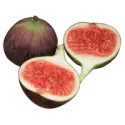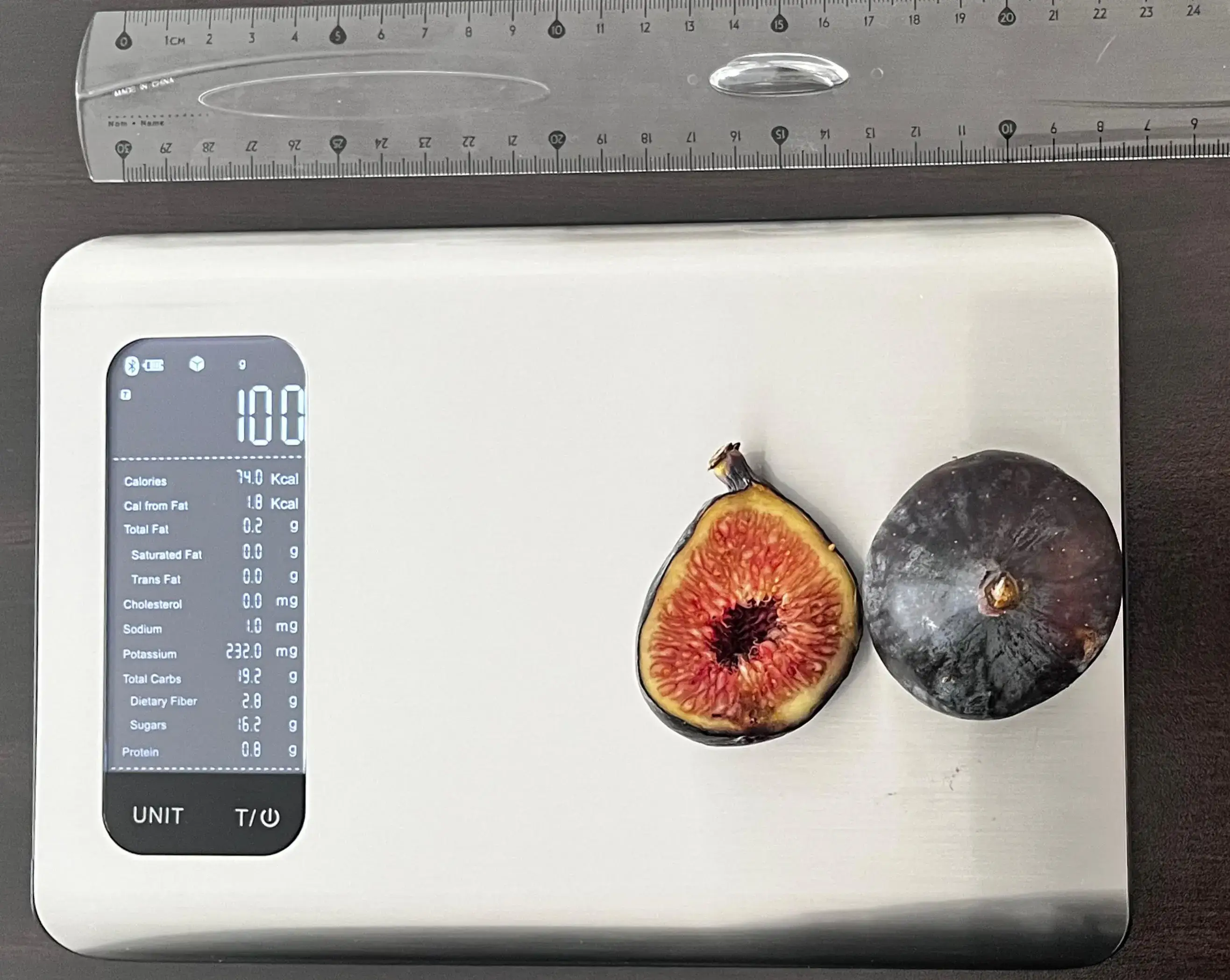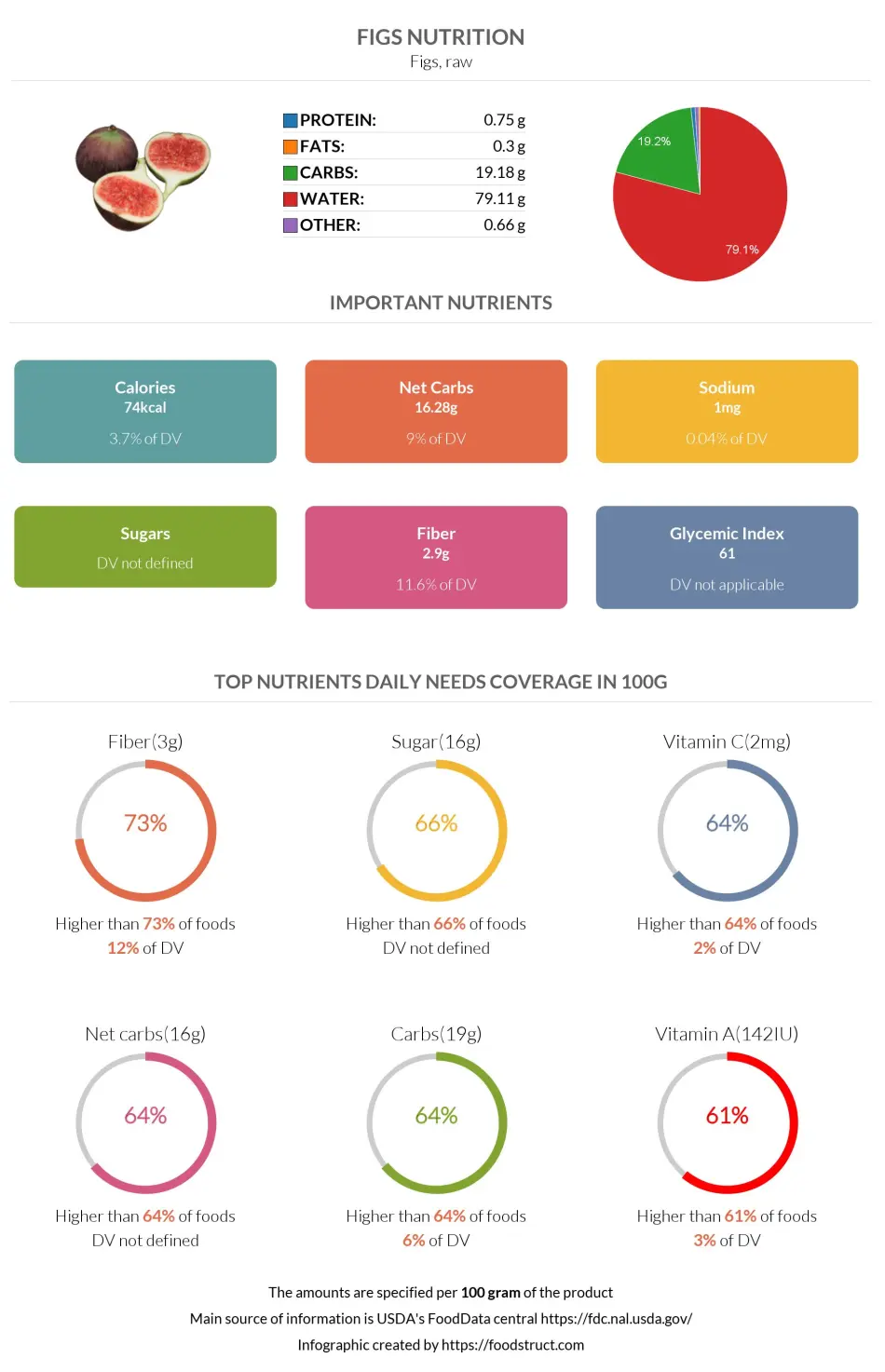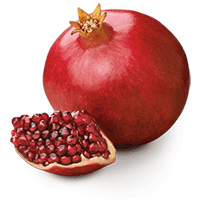Figs: In-Depth Nutrition, Diets, Health, & More

Summary
Figs are low-calorie fruits, containing 78% of water and 22% nutrients, mainly carbohydrates. Around 15% of those carbs are dietary fiber, both insoluble and soluble, with a slightly higher content of insoluble dietary fiber. Figs are a good source of calcium, potassium, vitamins C, A, K, and B6.
Figs are also rich in phytochemicals, predominantly anthocyanins, rutin, and carotenoids, benefiting health. On the other hand, figs are high in oxalates, increasing the risk of developing calcium oxalate kidney stones in some people.
Introduction
The common fig (Ficus carica), or just fig, is the flowering plant of the eponymous tree. It is closely related to mulberries, being from the same Moraceae family. Fig trees have a rich history, accompanying humans' travels for centuries, being one of the earliest cultivated fruit trees. Today, they are also commonly used as ornaments.
Varieties
Figs come in various colors and sizes; however, they are almost always in a sack shape, with a soft inside that consists of hundreds of tiny seeds with a mellow, sweet taste. The most common figs we see have black and green peels and pink pulps. Namely, the four most well-studied horticultural varieties are the Caprifig, the Smyrna, the San Pedro, and, of course, the Common or the Adriatic, each having their own sub-varieties (1). The edible fig is a multiple accessory fruit botanically referred to as syconium.
Cultivation
The Greek philosopher Theophrastus, the founder of modern botany, described how insects enter and leave the figs (2). That is because each fig species has its own wasp pollinator, so wild fig fruits often have dead wasps in them. However, if the wasp doesn’t manage to leave the fruit in time, the enzymes will break it down as the fig ripens (3). That being said, modern agriculture has found ways to grow figs without the help of wasps as pollinators.
Figs are a year-round fruit, which is part of the reason, as well as the high calcium concentration, that ecologists consider to be a “keystone resource.” It is included in the diets of hundreds of species of insects, birds, mammals, reptiles, and even fish, dispersing the seeds wherever they go (4).
Nutrition
We will talk about the nutritional value contained in 100g of figs, which is the equivalent of two medium figs weighing 50g.
Figs are low-calorie fruits, containing 78% of water and 22% nutrients, mainly carbohydrates.
Macronutrients chart
Calories
A 100g serving, or two medium figs, provides only 74 calories, making figs relatively low in calories.
What Do 74 Calories or 100 Grams of Figs Look Like?
Our team conducted measurements to visually represent the weight and calorie content of 100 grams of figs. In the image below, you can observe that one and a half figs together make up 100 grams, equivalent to 74 calories. This implies that one individual fig weighs approximately 65 grams, with a calorie content of about 48 calories. It's essential to note that these values may vary based on the size and ripeness of the figs.

Protein
A 100g of figs contains less than 1 gram of proteins. Of its little protein, tryptophan, threonine, isoleucine, valine, and histidine are comparably in higher amounts.
Fat
Figs have almost no fats: 0.3g per 100g serving, meaning they are very low in saturated fats and have no trans fats or cholesterol.
Carbs
Fig fruits mainly contain water and carbohydrates as major macro nutritional components. The total carbohydrate amount per 100g of figs equals 19.18g.
Sugars
A 100g of figs contains 16.3g of sugars, around 85% of the total carbohydrate content.
Fiber
Figs contain 2.9g of fiber; however, the amount of fiber may vary depending on the growing region and fig variety.
Figs contain both insoluble and soluble dietary fiber, with a slightly higher content of insoluble dietary fiber (4).
Fiber content ratio for Figs
Comparison to Other Foods
Figs are often compared to other fruits in the same category. A good example could be this article, which compares figs and dates. In addition, the table below highlights some remarkable comparisons.
Vitamins
Figs are a great source of vitamin C, vitamin A, and vitamin K. They are also rich in vitamins B6, B1, B2, B3, and B5, listed in order of the amounts within, from high to low. Figs also contain some amounts of vitamin E, but they absolutely lack vitamin B12, vitamin B9, and vitamin D.
Vitamin coverage chart
Minerals
Figs contain copious amounts of calcium and potassium. They are also high in manganese, magnesium, copper, and iron.
Zinc, phosphorus, choline, and selenium can be found in low to moderate amounts. Figs are low in sodium.
Mineral coverage chart
Oxalates
Oxalates or oxalic acids are antinutrients found in many vegetables, nuts, fruits, and grains and are linked to calcium oxalate kidney stones.
People at risk of developing calcium oxalate kidney stones should avoid figs as they are high in oxalates.
According to one study, 100g of dried figs contain 95mg of oxalates, whereas according to another, they contain 56.6mg (5, 6).
Phytochemicals
Phytochemicals, also called phytonutrients or antioxidants, are biologically active compounds produced by plants. Most benefit human health and decrease the risk of heart disease and cancer by scavenging free radicals.
The main phytochemicals in figs are anthocyanins, rutin, and carotenoids (lutein, zeaxanthin, β-cryptoxanthin, and β-carotene). However, other flavonoids and phenolic compounds, such as phenolic acids, flavones, flavonones, flavonols, and proanthocyanidins, are also present.
Darker varieties and fresh figs are richer in phytochemicals. Growing region, variety, harvesting time, and ripeness of fig also affect its phytochemical content (7).
PRAL
Food’s PRAL or Potential Renal Acid Load value shows how much acid is produced in the organism by the given food. The PRAL value of fig is -4.9, making it alkaline or base-producing.
Health Impact
Figs can be eaten fresh or dried. The nutritional value of a fresh fig is sometimes higher; however, they are susceptible to physical damage, and dried figs are a way to spread figs beyond the areas that produce them. Dried fruits have been proven to have greater nutrient density, increased shelf life, and greater phenol antioxidant content than fresh fruits. Dried figs can significantly increase the antioxidant capacity of blood plasma for 4 hours after consumption (8).
Allergy
Fig allergies are not that common, with only a few cases reported. The main manifestations are usually either an anaphylactic reaction or an oral allergy syndrome. People with a fig allergy can often feel a tingling, itching, or swelling sensation in the mouth right after consuming the fruit. The most common allergens in figs are the proteins related to the skin (9).
Fig trees can also cause skin rashes, called phytophotodermatitis, due to compounds within fig leaves called furocoumarins, consisting of psoralen, bergapten, and others. Phytophotodermatitis is a toxic reaction due to skin exposure to certain plants, followed by exposure to sunlight. It is not a photoallergic reaction but rather a phototoxic one, meaning prior sensitization is not necessary, and anyone can be affected by it (10).
Scientists have discovered a cross-reactivity between fig fruit, the weeping fig, and other fruits like kiwi, papaya, avocado, pineapple, and banana. Dependent sensitization to rubber latex allergens was not found (11).
Diabetes & Glycemic Index
Studies have found that due to a phytohormone called abscisic acid, fig fruit extract supplementation can be a promising nutritional change for diabetes management. It may improve acute postprandial glucose and insulin homeostasis and be a possible adjunctive treatment for blood sugar management in prediabetes and type 2 diabetes (12, 13).
Another research has treated experimental diabetes in rats with fig fruit extracts, confirming that figs’ antioxidant properties ameliorate diabetic conditions (14).
Dried figs have a medium glycemic index value of 61 and a low glycemic load of 5. Compared to dried figs, dates and raisins have a higher glycemic index.
However, prunes, dried apples, peaches, and apricots have a lower glycemic index (15).
Incorporating a decoction of fig leaves as a supplement for breakfast has been proven to help patients with type 1 diabetes lower their daily required insulin dose by 12% (16).
The aqueous extract of Ficus carica leaves has been proven to have significant hypoglycemic effects in streptozotocin-diabetic rats after an oral or intraperitoneal administration (17).
Cancer
Compounds within fig latex, like sitosterols and acyl moieties, primarily palmitoyl and linoleyl alcohol, have been established to be potent cytotoxic agents, showing inhibitory effects on the proliferation of various cancer cell lines during in vitro experiments (18).
Fig tree latex and leaves can be used as a potential treatment for colorectal cancer cells due to their antiproliferative and apoptosis-inducing qualities (19).
Another study has found the active compounds bergapten and psoralen to play an important role in the anticancer effects of fig tree leaves. Ficus carica leaves can be a good source to use in the development of drugs for suppressing cancer cell growth and migration against breast cancer (20), as well as cervical (21) and liver cancers (22).
Cardiovascular System
Research has shown that the aqueous methanol extract of the fig fruit decreases the blood pressure of glucose-induced hypertensive rats, presenting with strong negative inotropic and chronotropic effects (23). This makes the fig fruit a potential substance for developing natural hypotensive drugs.
Ficus carica leaf extracts can also play a role as a food supplementation for poultry, as adding the extract significantly reduces the levels of triglycerides and total cholesterol production in poultry liver (24).
Other studies have also shown fig leaf extracts to have hypolipidemic (blood lipid lowering) effects in lab animals. One study showed that the extract improves the lipid profile and decreases adipogenic risk factors in high-fat diet rats (25).
Another research found the leaves to significantly affect carbohydrate metabolism enzymes, promising hypoglycemic and hypolipidemic activities in type 2 diabetic rats (26).
Nevertheless, when it comes to the direct effects of the fig leaf extract on humans, it has not been proven yet. A study concluded that consumption of dried figs does not decrease serum low-density lipoprotein, or “bad” cholesterol, and total cholesterol concentrations. On the contrary, total cholesterol levels increased in the subjects (27).
The fruit has been studied to repress adenosine-5-diphosphate and adrenaline-induced human platelet aggregation, expressing antiplatelet activity. The ripe dried fruit also exhibited spasmolytic activity, most probably mediated by activating potassium ion ATP channels (28).
Digestive System
Figs are often used in traditional medicine to treat constipation and various digestive issues. Scientists have researched some of those effects.
A study has shown the aqueous extract of fig leaves to have a natural laxative effect without causing diarrhea and to ameliorate functional gastrointestinal motility disorders (29).
Figs can also be used as an effective treatment for constipation in animals, proving that fig paste may be useful as complementary medicine for people suffering from chronic constipation (30).
Consumption of figs may help people with irritable bowel syndrome, improving symptoms such as frequency of pain, frequency of defecation, abdominal distention, and stool consistency (31).
In different studies over the years, figs have also been researched to have many more properties, such as hepatoprotective, antibacterial, antipyretic, antituberculosis, anthelmintic, antimutagenic, antifungal, antiviral, anti-inflammatory, and others (28, 32).
Fig in Diets
| Keto | During a keto diet, it is best to limit your carbohydrate intake to less than 50g a day. Since 2 figs contain about 20g of carbohydrates, it is advised to avoid this fruit or use it only in moderation (33) |
| DASH | Figs are a good source of dietary fiber and potassium. They are also low in sodium, so they fit in both types of the DASH diet. |
| Atkins | Fruits are not allowed in Atkins Phase 1, and only a limited number of fruits, of which figs are not a part, are allowed in Phase 2. However, you can have figs in moderate amounts during the Atkins 20, Phase 3, and 4, as well as the Atkins 40 and the Atkins 100 diets (34, 35). |
| Mediterranean | Fresh fruit is essential to the Mediterranean diet, so figs fit perfectly in this one. |
| Paleo | A paleo diet includes plenty of fruits, and since fig trees are one of the oldest cultivated fruit trees, figs are a part of the paleo diet (36). |
| Vegan/ Vegetarian/ Pescetarian | Figs certainly suit vegetarian and pescetarian diets. However, it is debatable for a vegan diet since wasp pollinators are necessary to produce the fruit (37). Still, today, there are methods of cultivating fig trees that do not require wasp pollinators. |
| Dukan | Fruits are not allowed during the first two or Attack and Cruise phases of the diet, and you can only have one piece of fruit a day during the Consolidation Phase. Even though you can eat anything throughout the Stabilization phase, figs are one of the fruits that are advised to be avoided (38). |
| Intermittent Fasting | You can eat figs during the eating periods but not during fasting. |
| Low Fat & Low Calorie | Figs have almost no fats and only 74 calories in a 100g serving. So you can eat figs in limited amounts during a low-fat and low-calorie diet. |
| Low Carb | Two figs have almost 20g of carbohydrates, so you have to moderate the intake of these fruits during a low-carb diet. |
| Anti Inflammatory | Figs have strong antioxidant activities, as well as some anti-inflammatory qualities (28, 39). Figs suit this diet. |
| BRAT | Figs are to be avoided during a BRAT diet (40). |
| Low FODMAP | Figs are low in FODMAPs and may be the fruit of choice for people with IBS-C (constipation). |
References
- https://ucanr.edu/datastoreFiles/391-296.pdf
- http://www.bbc.com/earth/story/20170116-the-tree-that-shaped-human-history
- https://underthebanyan.blog/2016/08/25/true-or-false-figs-contain-dead-wasps/
- https://citeseerx.ist.psu.edu/viewdoc/download?doi=10.1.1.608.4943
- https://www.mdpi.com/2304-8158/12/17/3201
- https://www.jetir.org/papers/JETIR1804445.pdf
- https://www.ncbi.nlm.nih.gov/pmc/articles/PMC10255635/
- https://www.researchgate.net/publication/279625587
- https://pubmed.ncbi.nlm.nih.gov/12811022/
- https://www.researchgate.net/publication/5973917
- https://onlinelibrary.wiley.com/doi/full/10.1046/j.1365-2222.2003.01704.x
- https://pubmed.ncbi.nlm.nih.gov/31370154/
- https://diabetes.diabetesjournals.org/content/67/Supplement_1/791-P
- https://www.researchgate.net/publication/10815622
- https://www.ijmrhs.com/medical-research/dry-fruits-and-diabetes-mellitus.pdf
- https://pubmed.ncbi.nlm.nih.gov/9597370/
- https://onlinelibrary.wiley.com/doi/abs/10.1002/
- https://pubmed.ncbi.nlm.nih.gov/11473446/
- https://pubmed.ncbi.nlm.nih.gov/31472041/
- https://pubmed.ncbi.nlm.nih.gov/30100743/
- https://pubmed.ncbi.nlm.nih.gov/30705373/
- https://www.sciencedirect.com/science/article/pii/
- https://pubmed.ncbi.nlm.nih.gov/28187689/
- https://www.researchgate.net/publication/288392707
- https://pubmed.ncbi.nlm.nih.gov/23606376/
- https://pubmed.ncbi.nlm.nih.gov/28193094/
- https://www.ncbi.nlm.nih.gov/pmc/articles/PMC3169356/
- Review Article Ficus carica L. (Moraceae)
- https://pubmed.ncbi.nlm.nih.gov/29870788/
- https://pubmed.ncbi.nlm.nih.gov/22232635/
- https://www.sciencedirect.com/science/article/abs/pii/S1550830718301873
- https://www.researchgate.net/publication/328274172
- https://naturalmoreish.com.au/blog/are-figs-keto-friendly/
- https://www.atkins.com/how-it-works/atkins-20/phase-4/acceptable-foods-atkins-20-phase-4
- https://www.atkins.com/how-it-works/atkins-100/other-carbs-atkins-100#acceptable
- https://paleoleap.com/paleo-foods-figs/
- https://www.veganlifemag.com/should-vegans-eat-figs/#
- https://www.dukandiet.com/weight-loss-secrets/forbidden-fruits
- https://www.ncbi.nlm.nih.gov/pmc/articles/PMC5149042/
- https://www.oregonclinic.com/diets-BRAT#
Top nutrition facts for Figs

| Calories ⓘ Calories for selected serving | 74 kcal |
|
Glycemic index ⓘ
Source:
Check out our Glycemic index chart page for the full list.
|
61 (medium) |
| Glycemic load | 5 (low) |
| Net Carbs ⓘ Net Carbs = Total Carbohydrates – Fiber – Sugar Alcohols | 16 grams |
| Default serving size ⓘ Serving sizes are mostly taken from FDA's Reference Amounts Customarily Consumed (RACCs) | 1 medium (2-1/4" dia) (50 grams) |
| Acidity (Based on PRAL) ⓘ PRAL (Potential renal acid load) is calculated using a formula. On the PRAL scale the higher the positive value, the more is the acidifying effect on the body. The lower the negative value, the higher the alkalinity of the food. 0 is neutral. | -4.9 (alkaline) |
| Oxalates ⓘ https://www.sciencedirect.com/science/article/abs/pii/S0308814602002121 | 21 mg |
Figs calories (kcal)
| Calories for different serving sizes of figs | Calories | Weight |
|---|---|---|
| Calories in 100 grams | 74 |
Figs Glycemic index (GI)
Figs Glycemic load (GL)
Mineral chart - relative view
Vitamin chart - relative view
Protein quality breakdown
Fat type information
All nutrients for Figs per 100g
| Nutrient | Value | DV% | In TOP % of foods | Comparison |
| Vitamin A | 7µg | 1% | 54% | |
| Calories | 74kcal | 4% | 79% |
1.6 times more than Orange
|
| Protein | 0.75g | 2% | 88% |
3.8 times less than Broccoli
|
| Fats | 0.3g | 0% | 85% |
111 times less than Cheese
|
| Vitamin C | 2mg | 2% | 36% |
26.5 times less than Lemon
|
| Net carbs | 16g | N/A | 36% |
3.3 times less than Chocolate
|
| Carbs | 19g | 6% | 36% |
1.5 times less than Rice
|
| Cholesterol | 0mg | 0% | 100% |
N/A
|
| Vitamin D | 0µg | 0% | 100% |
N/A
|
| Magnesium | 17mg | 4% | 68% |
8.2 times less than Almonds
|
| Calcium | 35mg | 4% | 41% |
3.6 times less than Milk
|
| Potassium | 232mg | 7% | 52% |
1.6 times more than Cucumber
|
| Iron | 0.37mg | 5% | 81% |
7 times less than Beef broiled
|
| Sugar | 16g | N/A | 34% |
1.8 times more than Coca-Cola
|
| Fiber | 2.9g | 12% | 27% |
1.2 times more than Orange
|
| Copper | 0.07mg | 8% | 69% |
2 times less than Shiitake
|
| Zinc | 0.15mg | 1% | 87% |
42.1 times less than Beef broiled
|
| Phosphorus | 14mg | 2% | 91% |
13 times less than Chicken meat
|
| Sodium | 1mg | 0% | 98% |
490 times less than White bread
|
| Vitamin E | 0.11mg | 1% | 85% |
13.3 times less than Kiwi
|
| Manganese | 0.13mg | 6% | 58% | |
| Selenium | 0.2µg | 0% | 94% | |
| Vitamin B1 | 0.06mg | 5% | 67% |
4.4 times less than Pea raw
|
| Vitamin B2 | 0.05mg | 4% | 81% |
2.6 times less than Avocado
|
| Vitamin B3 | 0.4mg | 3% | 81% |
23.9 times less than Turkey meat
|
| Vitamin B5 | 0.3mg | 6% | 74% |
3.8 times less than Sunflower seeds
|
| Vitamin B6 | 0.11mg | 9% | 61% |
1.1 times less than Oats
|
| Vitamin B12 | 0µg | 0% | 100% |
N/A
|
| Vitamin K | 4.7µg | 4% | 56% |
21.6 times less than Broccoli
|
| Trans fat | 0g | N/A | 100% |
N/A
|
| Folate | 6µg | 2% | 76% |
10.2 times less than Brussels sprouts
|
| Choline | 4.7mg | 1% | 92% | |
| Saturated fat | 0.06g | 0% | 85% |
98.3 times less than Beef broiled
|
| Monounsaturated fat | 0.07g | N/A | 83% |
148.5 times less than Avocado
|
| Polyunsaturated fat | 0.14g | N/A | 82% |
327.6 times less than Walnut
|
| Tryptophan | 0.01mg | 0% | 97% |
50.8 times less than Chicken meat
|
| Threonine | 0.02mg | 0% | 96% |
30 times less than Beef broiled
|
| Isoleucine | 0.02mg | 0% | 96% |
39.7 times less than Salmon raw
|
| Leucine | 0.03mg | 0% | 97% |
73.7 times less than Tuna Bluefin
|
| Lysine | 0.03mg | 0% | 97% |
15.1 times less than Tofu
|
| Methionine | 0.01mg | 0% | 97% |
16 times less than Quinoa
|
| Phenylalanine | 0.02mg | 0% | 97% |
37.1 times less than Egg
|
| Valine | 0.03mg | 0% | 96% |
72.5 times less than Soybean raw
|
| Histidine | 0.01mg | 0% | 97% |
68.1 times less than Turkey meat
|
| Caffeine | 0mg | 0% | 100% | |
| Omega-3 - EPA | 0g | N/A | 100% |
N/A
|
| Omega-3 - DHA | 0g | N/A | 100% |
N/A
|
| Omega-3 - DPA | 0g | N/A | 100% |
N/A
|
Check out similar food or compare with current
NUTRITION FACTS LABEL
Serving Size ______________
Health checks
Figs nutrition infographic

References
All the values for which the sources are not specified explicitly are taken from FDA’s Food Central. The exact link to the food presented on this page can be found below.



